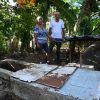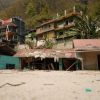Friday, April 26, 2024
News and Views from the Global South
EL SALVADOR: Most Water-Stressed Country in Central America
Edgardo Ayala
- Every night at 1:00 AM, Julio César Amaya gets up to turn on the faucet, because it is the only time that there is piped water in his neighbourhood – the poor district of San José, in the city of Soyapango, one hour east of the capital of El Salvador.
The water runs for only one hour. But sometimes he gets out of bed in vain for several nights in a row, because the water doesn’t come.
“When the water runs, we try to fill a big tank, so the water will last in case it doesn’t come back for three days,” Amaya, 69, told IPS.
According to projections by the Economic Commission for Latin America and the Caribbean (ECLAC) study “The Economics of Climate Change in Central America: Summary 2010” released in late November, this country of 6.1 million people will be hit hardest by water shortages in the region.
The United Nations agency reported that population growth in the region could drive up demand for water by nearly 300 percent by 2050 and by more than 1,600 percent by 2100, without factoring in the impact of climate change or improvements in efficiency in water use.
But “With climate change, demand may expand 20 percent more than in this baseline scenario,” and total availability of renewable water could fall 63 percent by 2100, from current levels.
According to these projections, El Salvador would be affected the most, followed by Honduras and Nicaragua.
In addition, ECLAC forecasts that the cumulative cost of the impact of climate change in Central America by 2100, in a scenario of continued intensive use of fossil fuels, could amount to 73 billion dollars, equivalent to 54 percent of the region’s GDP for 2008.
That estimate is based on the impact on agriculture, water resources and biodiversity, and on the increased intensity of hurricanes, storms and floods.
“Although it is estimated that Central America will continue to generate only a minimal part of the planet’s GHG (greenhouse gas emissions), it is already one of the regions most vulnerable to the consequences of these emissions,” the report says.
Environmentalists in El Salvador were not surprised by ECLAC’s projections.
“It’s not by chance that in Central America, El Salvador is the most water-stressed country,” Nelson Cuéllar, a researcher at the Research Programme on Development and the Environment (PRISMA), told IPS.
El Salvador is one of the most deforested countries in Latin America, and its high population density of 300 inhabitants per square kilometre, and the fact that 63 percent of the population lives in cities, lead to high demand for water, which is not available to everyone, Cuellar said.
Official figures from 2008 show that only 55 percent of rural-dwellers have piped water, compared to 90 percent of the urban population.
In the countryside, families not connected to the water grid depend on non-potable water from wells and rivers, which are also drying up due to the high demand.
El Salvador is the third most unequal country in the region in terms of access to water, according to the Human Development Report for Latin America and the Caribbean, “Acting On The Future: Breaking The Intergenerational Cycle Of Inequality”, published in July by the United Nations Development Programme (UNDP).
The UNDP study reports that 88 percent of the richest households in this country have access to water, compared to 44 percent of the poorest families.
Ángel Ibarra of the Salvadoran Ecological Unit (UNES), a local NGO, said man-made environmental damages have affected the water cycle, and today much of the surface water does not seep into the ground, replenishing aquifers, but instead flows uncontrolled, causing floods.
Meanwhile, many rivers dry up in the summertime, causing water supply problems for rural families.
All of these factors, he said, are linked to the country’s social and environmental vulnerability, generated by development models that have put business profits over the environment and people.
He was referring to the neoliberal policies followed during the 20 years that the right-wing Nationalist Republican Alliance (ARENA) governed the country, until President Mauricio Funes of the leftist Farabundo Marti National Liberation Front (FMLN) took office in June 2009.
“For years, real estate developers had no problem getting permits to build in unsuitable areas, because of their political connections,” Ibarra told IPS.
Unequal access to water is also aggravated by certain unethical or corrupt practices by wealthy sectors of the population.
ANDA, the government water and sanitation company, discovered in October that some 3,000 homes and businesses in the most exclusive parts of San Salvador had no water meters to measure usage, but instead paid a fixed monthly quota of just 2.29 dollars.
“It’s an absurd situation, where the rich pay a ridiculously small fee for water,” said Ibarra, adding that poor families without piped water pay up to two dollars for a barrel of water every day — in a country where 20 percent of the population lives on less than two dollars a day, according to the UNDP Human Development Report 2009.
He also described as “ludicrous” the cost of water for companies that use large quantities in their production processes, such as Coca Cola, which pay a mere 0.06 cents of a dollar per cubic meter.
A bill presented by social organisations in 2007, with the aim of boosting water quality and access for the population, has been stalled in Congress due to lobbying by powerful economic interests.
“Here there is water only where there is money; the rest of us are out of luck,” said Julio César Amaya, who gets by with the water he manages to collect by crawling out of bed every night.

 Print
Print



